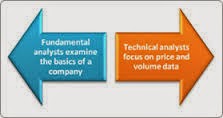Valuation
techniques are one thing which every investor should have grip on. If not
expert, then one should at least have the basic know how of the topic so that
they may evaluate their options when making investment decision. At the point of
investment there is range of assets available among which there are various kinds
of options so it gets quite difficult to calculate opportunity cost. Valuation
techniques can be categorized into absolute or intrinsic value or relative
valuation. Both of the approaches are valuable. Relative
valuation is
comparing prices of two assets having same properties trading in the market
whereas through absolute value we find the true value of asset by calculating
its net present value.
Let’s
talk about relative
valuation stocks 101
in particular to explain its usage in terms when and how it should be used. As
mentioned earlier relative value of an asset is found through comparing
variables of a similar asset, for example when buying smart phone, one can compare prices of similar smartphones
available in the market, having same properties and functions. Same goes for
the stocks, we compare its price, earnings, and company revenues from the other
stock trading in the same sector, industry or index. There are certain
valuation multiples which come handy when using relative valuation for choosing
a stock such as price
to earnings multiples,
price to book ratio, price
to sales ratio,
or even revenue
multiples etc.
The
key steps in doing relative valuation starts with finding comparable for your
stock that is appropriate to relate with. That is a stock of an oil company can
best match with the stock of another oil company trading in the same sector.
Second step is to standardize the comparable that is companies vary in size and
revenues they earn so it should be standardized against certain variable such
earnings per share. Third and last step is to mitigate any difference arises
even after standardization. Putting it in simple words, let’s say the price to
earnings multiple for Tesla Motors is way higher than Ford Motors and industry
average. There could be many reasons attached to it which can be analyzed by
analyst depending on their predictions, valuation and expertise.
So
all in all this how relative valuation is used, it will be further elaborated
in the next posts, till than enjoy valuing your assets.
